Guidelines for Protecting Youth Workers: Promote Safe Practices and Protect Youth Workers
ID
BSE-46NP (BSE-314P)
A large number of teenage workers in the U.S. engage in summer jobs for reasons such as personal development, gaining work experience, developing work skills, and generating funds for furthering their education and for spending money. Estimates show approximately 2.3 million teenagers engage in summer jobs annually. This total would be significantly higher if the thousands of teenagers engaged in agricultural work were also counted. However, they are not included in the statistics because they are exempt from OSHA work requirements.
Each year, many teen workers experience work-related injuries. Estimates show that the accident rate in the green industry is significantly higher than in other industries. The high rate may be attributed to the use of many different types of rather complex equipment, inadequate work experience among the workers, unsafe work environments, communication difficulties, and terrain conditions. Among youth workers, a 2006 study by V. Costilla and D.M. Bishal (see Resources) found the highest hospitalization rate was due to injuries caused by lawn mowers. A similar study by the U.S. Consumer Product Safety Commission reported more than 37,000 injuries related to riding mowers from 2003 through 2005. During the same period, there were 95 fatalities due to riding mower upsets. A study by the National Institute for Occupational Safety and Health observed 400 injuries per day and one death every 11 days due to workplace mishaps.

Significant reductions in the number of accidents and injuries are possible by following safe practices when operating equipment. When inexperienced workers are hired, they should be trained before they are assigned a task. Training may include topics such as safe operation and maintenance of different equipment, common accidents associated with different equipment and ways to prevent them, and use of personal protective equipment for protecting workers.
The goal of this training guide is to reduce the number of accidents and related injuries among the youth workers in the green industry by making workplaces safer. This guide is primarily for employers or supervisors of youth workers in the green industry. In addition to familiarizing the employers/supervisors with the regulations associated with hiring youth workers, the guide discusses the steps they can take to make their work environments safer. It also covers the responsibilities of guardians and youth workers for making workplaces safer.
Major Players and Their Responsibilities
When a youth worker is hired, the three groups directly responsible for making the workplace safer and for protecting the youth are (1) the employers/supervisors, (2) the youth workers, and (3) their guardians. Direct participation of all three groups is essential to making the workplace safer. For example, when the task for the youth worker is to be selected, all three groups should be directly involved, and it should be assigned by taking into consideration factors such as age, size, prior experience, interests, and abilities. Guardians and employers/supervisors must also share the responsibility of stressing the importance of safety and making workplaces safer.
Responsibilities of Employers/ Supervisors
Federal Regulations

In 1970 the U.S. Congress passed into law the Occupational Safety and Health Administration Act. This act established OSHA, which was given the responsibility for ensuring a safe and healthy work environment for every worker in the nation. All businesses are required by law to meet OSHA standards and to provide jobs free of hazards for their employees. The regulations also address how businesses can protect workers and improve workplace safety.
Rules and regulations are much stricter when young workers are employed. It is extremely important that employers/supervisors become familiar with OSHA regulations and provide a safe workplace. OSHA regulations are updated periodically. For the most current information, employers should visit the OSHA website at www.osha.gov.
Evaluation of Crew Members
Each and every crew member hired must be evaluated for his or her work experience, interests, background, and abilities. This information is essential in order to match individuals with responsibilities they can manage safely and to custom design training programs for them. It is the responsibility of the employers/supervisors to match young workers with responsibilities they can manage, ranging from simple manual labor to operating highly sophisticated equipment.
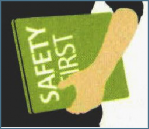
Training Program
An important responsibility of employers/supervisors is to custom design training programs that emphasize safe practices for the employees. As part of the training program, all employees must be given the opportunity to study the operator’s manuals and become familiar with the operation of the machines they will be working with. Operator’s manuals contain valuable information on how to operate the machine safely, potential hazards associated with the machine, safety features, maintenance information, and recommendations for personal protective equipment during the operation of the equipment. A typical training program for youth workers in the green industry may include the following (see the Resources and Training Modules sections):
Rotary mower safety (see fig. 1).
Tractor safety.
Utility type vehicles safety.
Hand tools safety.
Powered hand tools safety.
Guidelines for protecting youth workers.
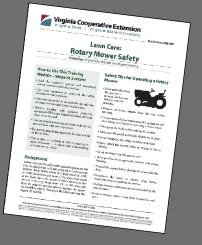
Periodic Performance Evaluation
Once the training is over and the employees are working, periodic on-the-job performance evaluation is important to make workplaces safer. These may be announced or unannounced evaluations. The employers/supervisors should share the results of an evaluation with the employees and suggest ways they can improve their performance. If any safety violations were observed during the evaluation or at any other time, they should be immediately shared with the employee and corrected.
Meetings With the Crew
It is a good practice for employers/supervisors to have periodic meetings with youth workers. A portion of such meetings should be dedicated to discussions on safety issues associated with the assigned responsibilities. In addition to stressing the importance of workplace safety, employers/supervisors should discuss safety violations and near misses by youth workers and the steps they can take to prevent future mishaps. Sharing stories of individuals injured by equipment mishaps can be an effective way of stressing workplace safety.
Personal Protective Equipment
OSHA regulations require the use of personal protective equipment to protect workers. Youth workers engaged in lawn care or landscaping work need more protection than what work clothes can provide. Employers/supervisors must be familiar with the functions and uses of personal protective equipment to assign the right equipment for the job to the youth workers.

Hard hats are effective at protecting heads against bumps and falling objects. While hard hats are recommended for all workers, they are particularly important for those who are engaged in construction work, tree trimming, and on jobs with a potential for falling objects (fig. 2). American National Standards Institute Z89.1 code certified hard hats are recommended for use by workers.
Eyes must also be protected from flying objects, chemicals, dust, and chaff. Protective eyeglasses are highly recommended when power equipment is operated outdoors (fig 2). ANSI Z87.1 code certified eye protection equipment is recommended.
Continuous exposure to high noise levels can cause hearing loss, and workers should be protected from outdoor power equipment noise. Hearing loss may occur when one is exposed to noise levels of 85 decibels or greater continuously. The sound level and the sound pressure level double for every 3 dB and 6 dB rise in sound level, respectively. For this reason, the safe exposure period halves for every 5 dB rise in sound level. In other words, if the allowable exposure time to a noise level of 90 dB is eight hours per day, it goes down to four hours per day when one is exposed to a noise level of 95 dB.
Protective devices ranging from earplugs to earmuffs are available to protect the hearing of youth workers (see table 1). Ear protective devices are selected based on a noise reduction rating. This rating indicates the noise reduction provided by the device. For example, an ear plug with a noise reduction rating of 26 may
Table 1. Types of hearing protection and instructions for proper use.
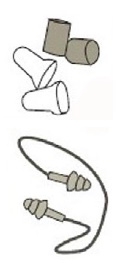
Earplugs
Clean hands.
Roll earplug between fingers to compress it.
Grasp ear from behind head with the opposite hand and pull up to straighten ear canal.
Insert earplug until it blocks sound, then hold it in place while it expands. (Count to 20 while it expands.)
Earplug must completely fill ear canal.
Test the fit by cupping hands over the ears and then releasing. There should not be much difference in noise level.
Wash reusable earplugs in warm, soapy water. Throw away disposable plugs after each use.

Hearing bands
Grasp ear from behind head with the opposite hand and pull up to straighten ear canal.
Use hands to press the ear pads into the ear canals.
Test the fit in a noisy environment: Lightly press the band inward. There should not be much reduction in noise level.

Earmuffs
Make sure the cushions fully cover the ear and seal tightly against the head.
Hold the headband at the crown of the head and adjust each cup.
Test the fit in a noisy environment: Gently push the cups toward the head and release. There should not be much difference in noise level.
potentially reduce the noise level the inner ear is experiencing by 26 dB. Unfortunately, the real noise level reduction that can be expected is only half the rated reduction. While earplugs are good for ear protection, earmuffs are more effective because they have the added advantage of keeping dust and dirt out of the ear canal. The employer/supervisor can use noise level meters to identify noise sources the workers have to be protected from.
Cuts, abrasions, and skin irritations are common when engaged in outside work. These may be prevented with the use of gloves. Leather gloves are more effective in terms of protection and gripping power. Canvas and cotton gloves are also good for providing limited protection. However, they are not recommended for handling chemicals and pesticides because they absorb and expose the user to the chemicals. Nitrile gloves are the best for handling chemicals.
Workers who work under dusty conditions should always wear respiratory protection devices. A wide variety of these devices ranging from mask respirators to full face respirators are available. Their effectiveness may vary depending on their design. For example, while some devices are designed to filter out dust, others are designed to filter out pesticide vapor. For this reason, it is important that the user select the device based on his or her specific needs.
Equipment Upkeep
Workers engaged in lawn care use different equipment to fulfill their day-to-day responsibilities. How well the equipment works and how safe it is depend on how well it is maintained. This responsibility should be assigned to a senior member of the organization. The upkeep may include maintenance, repairs, and tightening of all loose guards and shields. Poorly maintained machines are unsafe and may result in breakdowns and injuries.
Personal Health Issues
Lawn care workers generally work under extreme weather conditions that range from very cold to very hot. Employers/supervisors should be familiar with the steps they must take to protect their workers when they are exposed to these weather conditions. They should also know what to do when the workers are stressed by extreme temperatures. It is difficult for anyone to be highly productive under extreme weather conditions.
While it is impossible to control the weather, it is possible to protect the human body.
When working in the cold, one should dress appropriately to keep warm. For example, bulky clothes such as a snowmobile suit may not be appropriate when working in the cold.
In hot, humid conditions, workers may lose a significant amount of water due to excessive perspiration. Under these conditions, they must drink enough water to compensate for the loss and to maintain normal body temperature. Working in high temperature and high humidity conditions may also cause the body to overheat quickly due to reduced evaporative cooling resulting from reduced sweat evaporation.

Employers/supervisors should also be concerned about skin cancer due to overexposure to sun. Precautionary measures must be taken to protect employees. Individuals most at risk are those with fair complexions and those who burn easily. Employers may adopt steps such as providing protective clothing to cover the skin; headwear to cover the face, ears, and neck; and good sunscreen to protect exposed skin from the sun.
Bees, wasps, hornets, and yellow jackets are also major concerns among workers engaged in lawn care and landscaping. It is estimated that approximately 2 million people in the U.S. are allergic to insect venom. Every year, 90 to 100 deaths occur from reactions to insect stings. Employers/supervisors should be familiar with the steps they must take to counteract insect bites or stings. It is also important to familiarize the employees with this information.
Hand Signals for Communication
Most equipment used in lawn care operations is extremely noisy, and, therefore, the best way to communicate with fellow workers when machines are running is to use hand signals. Employers/supervisors and crew members should be able to communicate effectively with hand signals to prevent accidents and save time. For consistency and to minimize confusion, several engineering societies have standardized the hand signals and their meaning and they are summarized in figure 3.

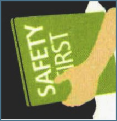
Checklists
Workplace safety may be improved significantly by restricting who can operate each machine. Depending on training, age, experience, skill, and interest, all youth workers may not be able to operate all machines used in lawn care.
The number of machines that can be operated by each worker might vary from person to person. For this reason, it is a good practice that employers/supervisors maintain a list of employees and the equipment each is authorized to operate. Such a list will prevent unauthorized individuals using the equipment without prior experience. For this system to work efficiently, it is critical that the checklist is current.
General Safety Rules
Most equipment used in lawn care and landscaping is simple and straightforward to use. However, if it is not operated carefully, it has the potential for accidents and injuries. In order to make the workplace safer and to reduce the number of mishaps, employers/supervisors may enforce the following general safety rules for youth workers to strictly follow.
Develop a “safety first” attitude among the youth workers.
Ensure that crew members are physically and mentally prepared to operate the equipment.
Never operate machines under the influence of drugs and/or alcohol.
Never operate machines when using a cell phone or music listening devices.
Receive training prior to operating a machine.
Use personal protective equipment and protective clothing for personal protection.
Never allow additional riders on machines. Most machines are designed only for one person — the operator.
Ensure that no bystanders are in the work areas.
Refuel the equipment only when its engine is turned off and cold.
Turn off the engine and remove the switch key when the equipment is parked or left unattended. This is also true when troubleshooting, unclogging, and repairing a machine.
Make sure that all safety guards and shields are in place and intact prior to operating a machine.
Equip all tractors with rollover protective structures.
Display a slow moving vehicle emblem (fig. 4) on lawn care equipment that is taken on roadways.
Maintain proper speed.
Avoid operations on steep slopes to prevent equipment roll over.


Child Labor Laws
Virginia’s child labor laws help to protect the health and safety of young workers and to prevent their exploitation. They also ensure that work does not interfere with the youth workers’ academic studies. Lawn care businesses employing youth workers should be familiar with the laws and are required to enforce them strictly. The laws clearly spell out how minors can qualify for employment, the types of work activities minors are allowed to engage in, and how long minors are allowed to work each day during the academic year and during the summer.
Employers and supervisors employing minors are responsible for protecting them from injuries. This means that an employer cannot put a minor in a situation that can endanger his or her life or health. Employers must understand the laws clearly and must strictly enforce them to avoid severe civil and criminal penalties.
It is also important to note that while an employer is in compliance with state laws, the potential exists that he or she may be in violation of the Federal Fair Labor Standards Act. Employers who are covered by federal law must ensure that they are in compliance with federal as well as Virginia laws.
Responsibilities of Youth Workers
The youth workers engaged in lawn care and landscape activities play an important role in keeping their workplace safe because they are directly involved in carrying out the operations. There are a number of precautionary measures they can take to accomplish this. The following are selected examples of such measures that young workers can take to reduce the number of accidents and associated personal injuries.
Study the operator’s manual carefully and become familiar with the safety features of the machines, maintenance details, and operation before operating any equipment.
Get trained on the safe use of machines before operating them.
Make sure the equipment to be used is maintained properly and all the safety features of the equipment are in place and functional.
Make sure all the guards and shields are in place properly.
Understand OSHA regulations and the responsibilities of the employer in terms of providing a safe workplace. When safety violations occur, bring it to the attention of the employer/supervisor for corrective actions.
Use personal protective equipment and appropriate clothing for protection when working.
Make sure that an adequate supply of water and a first aid kit are available when working in the field.
Report repair and maintenance needs to the supervisor responsible for them.
Review resources for young workers by going to https:www.dol.gov/general/topic/youthlabor/studentworkers.
Responsibilities of Guardians
Guardians play an important role in improving workplace safety when young workers are involved. Guardians are generally the first to introduce young people to workplace safety, so they must take time to discuss and instill the importance of safety at the workplace. Starting from a very young age, children should be taught how different equipment can be used safely. As children grow up, guardians should introduce them to different power equipment commonly used in and around homes. When they are ready, young people should be given the opportunity to operate the equipment safely while under the guardians’ supervision. When youth are ready to join the workforce, the guardians should be directly involved in selecting the right job for their young workers. While they are working, it is a good practice for guardians to learn more about their work activities and the safety practices they are using. Guardians should also make sure that personal protective equipment and other protective devices are readily available to the youth workers and that they are using them effectively. The direct involvement of guardians will be beneficial in assessing how committed the employer is in providing a safe workplace. Guardians should also be familiar with the resources for parents of young workers available on the U.S. Department of Labor website at
www.dol.gov/compliance/topics/safety-health-youth.htm.
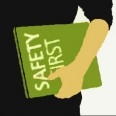
Pledge Sheet
While it is the responsibility of the employer to provide the youth workers with a safe workplace, both the guardians and youth workers play critical roles in keeping the workplace safe and reducing the number of accidents and associated injuries. For this reason, the guardians and youth workers are asked to understand their responsibilities and to sign a pledge sheet included in the appendix to demonstrate their commitment to keeping the workplace safe.
Resources
Virginia Cooperative Extension Publications
Lawn Care: Hand Tools Safety, VCE publication BSE- 98P – https://www.pubs.ext.vt.edu/BSE/BSE-40/BSE-40.html
Lawn Care: Powered Hand Tool Safety, VCE publication BSE-97P – https://www.pubs.ext.vt.edu/BSE/BSE-41/BSE-41.html
Lawn Care: Rotary Mower Safety, VCE publication BSE-96P – https://www.pubs.ext.vt.edu/BSE/BSE-42/BSE-42.html
Lawn Care: Tractor Safety, VCE publication BSE-100P – https://www.pubs.ext.vt.edu/BSE/BSE-43/BSE-43.html
Lawn Care: Utility-Type Vehicle Safety, VCE publication BSE-99P – https://www.pubs.ext.vt.edu/BSE/BSE-44/BSE-44.html
Training Modules
Ohio State University Extension Trainer Modules
Tailgate Safety Training for Landscaping and Horticultural Services Agricultural Safety Program https://agsafety.osu.edu/sites/agsafety/files/imce/OSU% 20Tailgate%20Safety%20Training%20-%20Landscape% 20-%20English_0.pdf
Sample titles and publication numbers from the series:
Bee, Wasp, Hornet, and Yellow Jacket Stings for Trainers and Supervisors, AEX 192.2.03
Caught In or Between Objects for Trainers and Supervisors, AEX 192.2.05
Equipment and Plant Transport for Trainers and Supervisors, AEX 192.2.13
First Aid Kit for Trainers and Supervisors, AEX 192.2.16
First on the Scene for Trainers and Supervisors, AEX 192.2.17
Hand Signals for Vehicle Safety for Trainers and Supervisors, AEX 192.2.21
Introduction to Safety in Landscaping and Horticulture Services for Trainers and Supervisors, AEX 192.2.24
No Riders on Lawn Equipment for Trainers and Supervisors, AEX 192.2.32
Personal Eye Protection for Trainers and Supervisors, AEX 192.2.35
Poison Ivy, Poison Oak, and Poison Sumac for Trainers and Supervisors, AEX 192.2.37
Power Lawn Mowers for Trainers and Supervisors, AEX 192.2.39
Power-Take-Off (PTO) Shielding for Trainers and Supervisors, AEX 192.2.40
Preventing Lifting and Overexertion Injuries for Trainers and Supervisors, AEX 192.2.44
Preventing Machine Hazards for Trainers and Supervisors, AEX 192.2.45
Protecting Against Cold for Trainers and Supervisors, AEX 192.2.48
Protecting Against Noise for Trainers and Supervisors, AEX 192.2.49
Protecting Hands and Fingers for Trainers and Supervisors, AEX 192.2.50
Protecting the Head for Trainers and Supervisors, AEX 192.2.51
Protective Gloves for Trainers and Supervisors, AEX 192.2.52
Repetitive Motion for Trainers and Supervisors, AEX 192.2.54
Rollovers and Rollover Protective Structures (ROPS) for Trainers and Supervisors, AEX 192.2.56
Rotary Lawn and Brush Mower Safety for Trainers and Supervisors, AEX 192.2.57
Safe Use of Hand-Held Tools for Trainers and Supervisors, AEX 192.2.61
Safe Use of the Power-Take-Off (PTO) for Trainers and Supervisors, AEX 192.2.64
Safe Use of Tractors and Self-Propelled Equipment for Trainers and Supervisors, AEX 192.2.65
Safely Starting and Stopping a Tractor for Trainers and Supervisors, AEX 192.2.66
Small-Engine Machine Safety for Trainers and Supervisors, AEX 192.2.70
Spider Bites for Trainers and Supervisors, AEX 192.2.71
Stress Management for Trainers and Supervisors, AEX 192.2.73
Substance Abuse and Accidents for Trainers and Supervisors, AEX 192.2.75
Sun Exposure for Trainers and Supervisors, AEX 192.2.76
Tick Bites for Trainers and Supervisors, AEX 192.2.79
Tractor Loader Safety for Trainers and Supervisors, AEX 192.2.80
Tractors, Towed Equipment, and Highway Safety for Trainers and Supervisors, AEX 192.2.81
Tree Pruning and Ladder Safety for Trainers and Supervisors, AEX 192.2.82
Tree Pruning, Trimming, and Felling Safety for Trainers and Supervisors, AEX 192.2.83
Workplace Violence for Trainers and Supervisors, AEX 192.2.86
Additional Resources
American Red Cross. 2007. “Heat (Heat Wave).” In Talking About Disaster: Guide for Standard Messages 60–68. Washington, DC: American Red Cross.
Commonwealth of Virginia. Office of the Attorney General. 2014. “Virginia’s Child Labor Laws.” Office of the Attorney General Web Page.
Costilla, V., and D. M. Bishai. 2006. “Lawnmower Injuries in the United States: 1996 to 2004.” Annals of Emergency Medicine 47 (6): 567–73.
Farm Safety Association. 2000. Young and New Worker Orientation and Training. Guelph, ON: Farm Safety Association.
Farm Safety Association. 2002. Health and Safety Guidelines for Agriculture, Horticulture and Land- scape Employers and Employees. Guelph, ON: Farm Safety Association.
Farm Safety Association. 2002. Landscape Safety Topics. Guelph, ON: Farm Safety Association.
Health and Safety Executive. 2014. “Personal Protective Equipment (PPE).” HSE Web Page.
Lind, S., and M. Ricketts. 2009. Mowing and Trimming Safety for the Landscaping and Horticultural Services Industry. Kansas State University Agricultural Experiment Station and Cooperative Extension Service. Publication MF-2714 rev. Manhattan, KS: K-State Research and Extension.
Margentino, M. R., and K. Malinowski. 1992. Farm Machinery and Equipment Safety; Part II: Preventing Machinery Accidents During Operation. Rutgers Cooperative Extension, New Jersey Agricultural Experiment Station. Publication FS620.
Ricketts, M., S. Lind, and K. Wieland. 2009. Instructor Guide for the Landscaping and Horticultural Services Industry. Kansas State University Agricultural Experiment Station and Cooperative Extension Service. Publication MF-2716 rev. Manhattan, KS: K-State Research and Extension.
Ricketts, M., S. Lind, and K. Wieland. 2010. Guide to Managing Safety for Employers and Supervisors in the Landscaping and Horticultural Services Industry. Kansas State University Agricultural Experiment Station and Cooperative Extension Service. Publication MF-2715 rev. Manhattan, KS: K-State Research and Extension.
U.S. Consumer Product Safety Commission. 2013. Riding Lawnmowers. CPSC Fact Sheet. Publication 588.
U.S. Department of Labor. Occupational Safety & Health Administration. 2012. “Youth in Agriculture: Noise.” OSHA Web Page.
U.S. Department of Labor. Occupational Safety & Health Administration. 2012. “Youth in Agriculture: Other Machinery.” OSHA Web Page.
U.S. Department of Labor. Wage and Hour Division. 2013. Child Labor Provisions for Nonagricultural Occupations Under the Fair Labor Standards Act. Child Labor Bulletin 101, WH-1330. Washington, DC: U.S. Department of Labor.
Acknowledgements
This publication was developed with the support of National Youth Farm Safety Education and Certification (Grant No. USDA/NIFA-2010-41521-20830), National Institute of Food and Agriculture, and the U.S. Department of Agriculture. The team that developed this publication is solely responsible for its content, and the content does not necessarily reflect the views of the U.S. Department of Agriculture or the U.S. Department of Labor. Team members are Robert Grisso, John Perumpral, Don Ohanehi, Mike Goatley, Kathleen Jamison, Cathy Sutphin, Dan Swafford, and Carl Estes.
The authors are grateful to Kansas State University and Mary Ann Zapalac Illustration for permission to use some of their images.
Appendix
Guardian Pledge
I, (print name), understand my responsibilities for improving workplace safety for youth workers. I pledge to take appropriate steps to accomplish this objective.
Signature_________________________________________________
Date ______________________
Youth Worker Pledge
I, (print name), understand the steps I can take as a young worker for improving the safety in the workplace. I pledge to take these steps to reduce the number of accidents and injuries at the workplace.
Signature_________________________________________________
Date ________________________
Virginia Cooperative Extension materials are available for public use, reprint, or citation without further permission, provided the use includes credit to the author and to Virginia Cooperative Extension, Virginia Tech, and Virginia State University.
Virginia Cooperative Extension is a partnership of Virginia Tech, Virginia State University, the U.S. Department of Agriculture, and local governments. Its programs and employment are open to all, regardless of age, color, disability, sex (including pregnancy), gender, gender identity, gender expression, national origin, political affiliation, race, religion, sexual orientation, genetic information, military status, or any other basis protected by law
Publication Date
January 29, 2024



